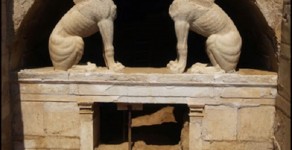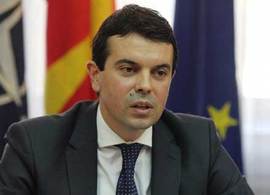
Paintings of daily life have been discovered on columns at Greece's biggest ancient tomb at Amphipolis in the northern region of Macedonia, the Greek culture ministry said Saturday. "After cleaning the columns, images of people, objects and utensils were uncovered," Culture Minister Kostas Tassoulas said at a press briefing on the discovery at the site.
The paintings may help solve the mystery of who is buried at the highly-decorated tomb from the time of Alexander the Great. A skeleton was found at the site earlier this month. "We will have the first indications (about the identity) after the bones are examined at an anthropological laboratory," said Lisa Mendoni, a top official at the culture ministry. Archeologists had to dig their way past huge decapitated sphinxes, break through a wall guarded by two caryatids and empty out an antechamber decorated with stunning mosaics to finally find the tomb's occupant.
The culture ministry said on November 12 the remains were clearly those of "a powerful personality, which can be seen from this unique tomb", with speculation rife that it could be that of Roxana, Alexander's Persian wife, his mother Olympias, or one of his generals.
Whoever was buried at the massive fourth-century BC structure, historians say it is highly unlikely to have been Alexander himself, who conquered the Persian empire and much of the known world before his death at the age of 32. A team from the University of Thessaloniki plans to use three-dimensional tomographic imagery to search the area for other tombs.
The latest discoveries at the Amphipolis tomb site - half a kilometre (0.3 mile) in circumference - have boosted tourism to the region. "The number of visitors to the Amphipolis museum has increased considerably. On recent weekends more than 1,500 people have come to the sites," said Tassoulas. The archaeologist in charge of the dig, Katerina Peristeri, is set to hold a press conference about the discoveries on November 29 in Athens.
The paintings may help solve the mystery of who is buried at the highly-decorated tomb from the time of Alexander the Great. A skeleton was found at the site earlier this month. "We will have the first indications (about the identity) after the bones are examined at an anthropological laboratory," said Lisa Mendoni, a top official at the culture ministry. Archeologists had to dig their way past huge decapitated sphinxes, break through a wall guarded by two caryatids and empty out an antechamber decorated with stunning mosaics to finally find the tomb's occupant.
The culture ministry said on November 12 the remains were clearly those of "a powerful personality, which can be seen from this unique tomb", with speculation rife that it could be that of Roxana, Alexander's Persian wife, his mother Olympias, or one of his generals.
Whoever was buried at the massive fourth-century BC structure, historians say it is highly unlikely to have been Alexander himself, who conquered the Persian empire and much of the known world before his death at the age of 32. A team from the University of Thessaloniki plans to use three-dimensional tomographic imagery to search the area for other tombs.
The latest discoveries at the Amphipolis tomb site - half a kilometre (0.3 mile) in circumference - have boosted tourism to the region. "The number of visitors to the Amphipolis museum has increased considerably. On recent weekends more than 1,500 people have come to the sites," said Tassoulas. The archaeologist in charge of the dig, Katerina Peristeri, is set to hold a press conference about the discoveries on November 29 in Athens.



 RSS Feed
RSS Feed
